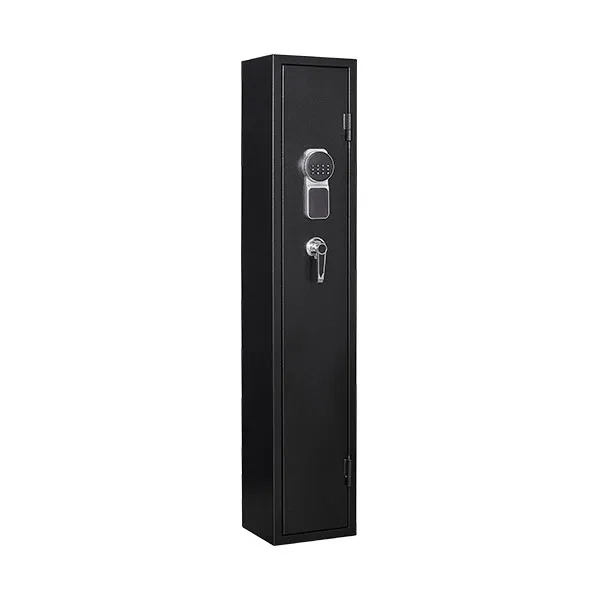Welcome to China Singdu Cabinets Manufacturer!
Changing the password (or combination/code) on your gun safe is crucial for security, especially if you've just acquired it, someone else knew the old code, or you suspect it might be compromised.

The exact method depends heavily on the TYPE of lock your safe has.
These are generally the easiest for owners to change themselves.
Crucial First Step: FIND YOUR SAFE'S MANUAL. The manual is the definitive guide for your specific model. If you lost it, check the manufacturer's website; they often have PDFs available.
Keep the Safe Door OPEN: NEVER attempt to change the code with the door closed and locked. If you make a mistake, you could lock yourself out permanently.
Locate the Reset Button/Sequence:
This is often a small button located on the inside of the safe door, near the hinge side or behind a small cover plate on the lock body itself (inside).
Some safes don't have a button but use a specific key sequence on the keypad itself (e.g., pressing and holding '0' or '*'). Your manual will specify this.
General Procedure (Varies by Manufacturer - CONSULT MANUAL!):
Open the safe door. Make sure the bolts are retracted.
Press (and sometimes hold) the reset button inside the door OR enter the programming sequence on the keypad as per your manual.
The safe will usually signal it's in programming mode (e.g., a beep, flashing light).
Enter your current code (if required by your model – some skip this if the reset button is pressed). You might get another confirmation signal.
Enter your new desired code (usually 3-8 digits, follow manual recommendations).
You'll likely get another signal (beep/light).
Re-enter your new code for confirmation.
The safe should give a final confirmation signal (e.g., multiple beeps, green light) indicating the new code is accepted.
TEST THE NEW CODE THOROUGHLY:
With the door still OPEN, try locking the safe (extend the bolts using the handle).
Enter the new code and verify the keypad accepts it (usually a beep/light) and allows you to retract the bolts.
Try the old code to ensure it no longer works.
Test the new code at least 3-4 times successfully with the door open before you even consider closing it.
Final Test: Once you are 100% confident the new code works, close the door, lock it, and test the new code one last time to open it.
Changing the combination on a mechanical dial lock is more complex and often requires a professional.
Check Your Manual: Some higher-end mechanical locks are designed for user combination changes, but they require a special "change key" and a very precise procedure using specific index marks on the dial. If your manual doesn't explicitly describe a user change process AND provide a change key, DO NOT attempt it yourself.
Most Require a Locksmith: For the vast majority of standard Group 2 mechanical locks (the most common type), changing the combination requires partial disassembly of the lock mechanism by someone trained.
Why? It involves physically repositioning the wheels inside the lock pack. Doing this incorrectly will permanently lock you out and likely require drilling the safe.
If You Need to Change It: Contact a certified safe technician or a reputable locksmith who specializes in safes. They have the tools and expertise to do it correctly and safely.

Biometric locks almost always have a keypad or other method as a backup.
Changing the Numeric Code: If your biometric lock also has a keypad, changing the numeric backup code usually follows the same steps as the Electronic Keypad Locks section above. Consult your manual.
Managing Fingerprints: Adding or deleting fingerprints typically involves accessing a programming mode (often using the existing master code on the keypad or a programming button inside) and then following prompts to scan new fingers or select existing ones for deletion. Again, the manual is essential here.
General Tips & Important Reminders:
READ THE MANUAL: This cannot be stressed enough. Procedures vary significantly between brands (Liberty, Cannon, Winchester, Sentry, Stack-On, Fort Knox, etc.) and even models within a brand.
DOOR OPEN: Always perform changes and initial testing with the safe door wide open.
TEST, TEST, TEST: Verify the new code works multiple times before closing the door. Verify the old code doesn't work.

Choose a Strong Code: Avoid obvious sequences (123456), birthdays, or addresses. Use a random sequence if possible.
Record Securely: Store your new code securely, but NOT inside the safe itself. Consider a password manager or a sealed note with a trusted individual.
Batteries (Electronic): Ensure your electronic lock has fresh, good-quality batteries before starting the change process. Low batteries can cause errors.
If you are unsure about any step, cannot find your manual, or have a mechanical lock, it's always best to call a professional locksmith or safe technician. The cost of a service call is far less than the cost and hassle of being locked out of your safe.
Share this page

Jun He Yun Gu Luoyang info&tech port #21-Unit 1-2nd floor-202, Lantai Road No.227, Y
Phone: 86-18739076120
E-mail: mike@singducabinet.com